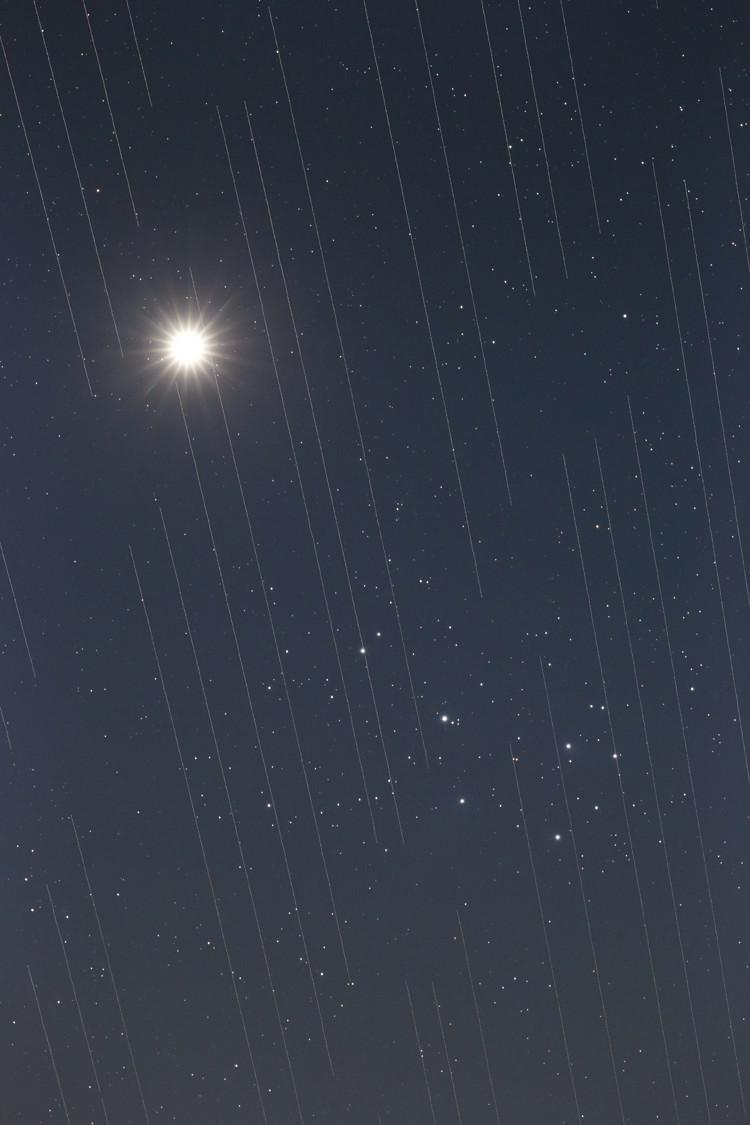This page describes an image Satellite swarm versus night sky beauty, by Torsten Hansen, Germany
Image caption:
Third place in the 2021 IAU OAE Astrophotography Contest, category Light pollution.
This image of Venus and the Pleiades also shows the tracks of the Starlink satellites. These satellites which are located at an altitude of approximately 550 kilometres, are part of an ever-growing constellation of satellites aimed to provide worldwide internet access. The reflective surfaces of the satellites, coupled with the fact that they are orbiting around the Earth, means that astronomical observations which require very long exposures capture “tracks” of the satellites in their images. Astronomical images used for scientific research are not usable because the measurements and data will contain these “tracks”. Because the number of satellites is expected to grow, it is likely that in the near future there will be no place on Earth where these satellites will not be visible crossing the sky. This is a new type of light pollution that seems to be an upcoming problem we will have to deal with, as these satellites might prevent optimal observation of the sky.
Scroll to captions in other languages
Image credit:
Torsten Hansen/IAU OAE
DOI: 10.5281/zenodo.5366442
Related glossary terms:
Artificial Satellite
, Light Pollution
Image license: Creative Commons Attribution 4.0 International (CC BY 4.0) Creative Commons Attribution 4.0 International (CC BY 4.0) icons
The media file captions presented on the OAE website were written, translated and reviewed by a collective effort from the OAE, the OAE Centers and Nodes, the OAE National Astronomy Education Coordinators (NAECs) and other volunteers. You can find a full list of credits for our translation project here. All media file captions are released under a Creative Commons CC BY-4.0 license and should be credited to "IAU OAE". The media files themselves may have different licenses (see above) and should be credited as listed above under "credit".
If you notice a factual error in this caption or an error in any of its translations then please get in touch.
Captions in Different Languages:
Image caption: Terzo posto al concorso di astrofotografia IAU OAE 2021, categoria Inquinamento luminoso.
Questa immagine di Venere e delle Pleiadi mostra anche le tracce dei satelliti Starlink. Questi satelliti, che si trovano a un'altitudine di circa 550 chilometri, fanno parte di una costellazione di satelliti in continua crescita che mira a fornire accesso a Internet in tutto il mondo. Le superfici riflettenti dei satelliti, unite al fatto che i satelliti orbitano intorno alla Terra, fanno sì che le immagini ottenute in osservazioni astronomiche che richiedono esposizioni molto lunghe catturino le "scie" dei satelliti nelle loro immagini. Le immagini astronomiche destinate alla ricerca scientifica non sono utilizzabili perché le misure e i dati contengono queste "scie". Poiché si prevede che il numero di satelliti crescerà, è probabile che nel prossimo futuro non ci sarà luogo sulla Terra in cui questi satelliti non saranno visibili mentre attraversano il cielo. Si tratta di un nuovo tipo d'inquinamento luminoso con cui dovremo fare i conti, poiché questi satelliti potrebbero impedire un'osservazione ottimale del cielo.
Image credit: Torsten Hansen/IAU OAE
Related glossary terms: Inquinamento luminoso , Satellite artificiale Caption translation status: Approved by a reviewer
Caption translators: Giuliana Giobbi, Francesco Salvestrini
Caption reviewers: Rosa Valiante, Silvia Casu, Anna Wolter
Image caption: 2021 年国际天文学联合会 OAE 天文摄影比赛光污染类第三名。
这幅金星和昴星团的图像还显示了星链卫星的轨迹。这些卫星位于大约 550 公里的高空,是不断扩大的卫星群的一部分,旨在提供全球互联网接入。卫星的反射表面,以及它们围绕地球运行,意味着需要长时间曝光的天文观测会在图像中捕捉到卫星的 "轨迹"。由于测量结果和数据包含这些 "轨迹",这导致用于科学研究的天文图像无法使用。卫星的数量预计会不断增加,在不久的将来,地球上可能再无任何地方能避开这些卫星划过天空的轨迹。这是一种新型的光污染,似乎正成为我们即将要面对的问题,因为这些卫星可能会阻碍对天空的最佳观测。
Image credit: Torsten Hansen/IAU OAE
Related glossary terms: 人造卫星 , 光污染 Caption translation status: Not yet approved by a reviewer
Caption translators: Hu Xueying
Image caption: 2021 年國際天文學聯合會 OAE 天文攝影比賽光汙染類第三名。
這幅金星和昴星團的圖像還顯示了星鍊衛星的軌跡。這些衛星位於大約 550 公裡的高空,是不斷擴大的衛星群的一部分,旨在提供全球互聯網接入。衛星的反射表面,以及它們圍繞地球運行,意味著需要長時間曝光的天文觀測會在圖像中捕捉到衛星的 "軌跡"。由於測量結果和數據包含這些 "軌跡",這導致用於科學研究的天文圖像無法使用。衛星的數量預計會不斷增加,在不久的將來,地球上可能再無任何地方能避開這些衛星劃過天空的軌跡。這是一種新型的光汙染,似乎正成為我們即將要面對的問題,因為這些衛星可能會阻礙對天空的最佳觀測。
Image credit: Torsten Hansen/IAU OAE
Related glossary terms: 人造衛星 , 光汙染 Caption translation status: Not yet approved by a reviewer
Caption translators: An automated transliteration from the simplified Chinese translation by - Hu Xueying









